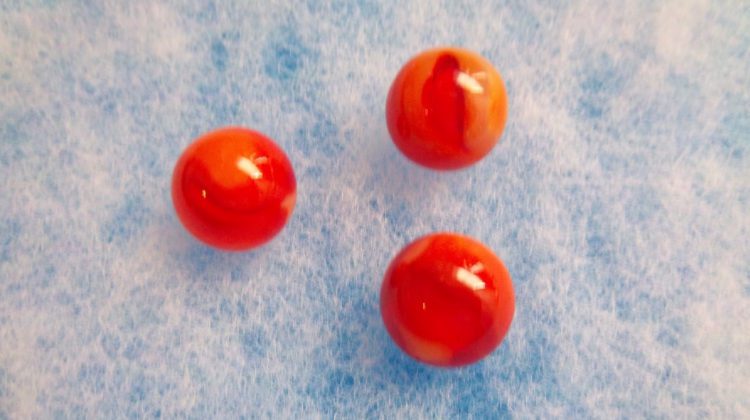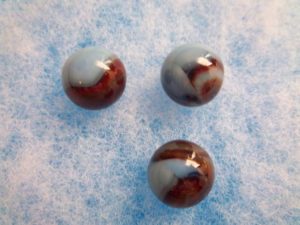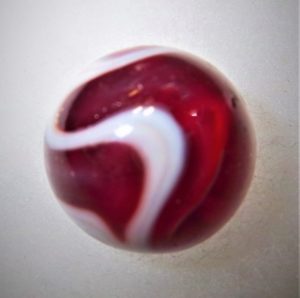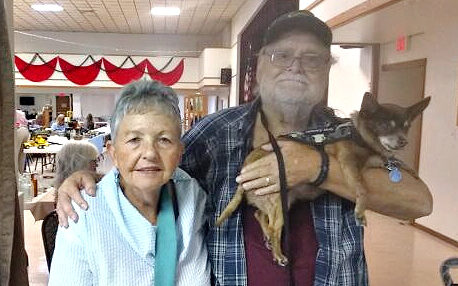
You Have What?
There are marbles in our collection made using cullet from well-known glasshouses which are extremely popular and often older and well-established. These companies never produced marbles or have ceased their production. For example, we have a clutch of marbles made from Burmese uranium glass made by The Fenton Art Glass Company in Williamsburg, WV. We bought these in 2010 in the Fenton gift shop. In 2011, and again at the plant, we bought Kokomo Opalescent Glass Company, Inc. marbles made by Jabo. Of course, Kokomo did make marbles for a brief period about 1939 – 1942 but the Company has always specialized (since 1888) in cathedral and specialty sheet glass.
This past summer we bought a presentation box of marbles made of glass shards from the Heisey Glass Company in Newark, Ohio. The Company, founded in 1896, closed in 1957. We have no idea who ran these marbles but they are gorgeous and translucent.
We also have a very small lot of marbles run from Akro Agate cullet. No, this is not the original cullet used to produce marbles. The glass shards were from our own giant display case of Akro utility and children’s glassware which flipped over and crashed. Dave McCullough ran the marbles for us at Dave’s Appalachian Swirls in Pennsboro, WV. Think about this: marbles were first made by Akro Agate, then their cullet was cast into children’s dishes, which 70 years later shattered; and then the shards were re-made into marbles!
A Marriage Made in Heaven
But without question one of the most lasting and productive uses of cullet from a glasshouse which reportedly did not make marbles was the symbiotic relationship between Cambridge Glass Company and Christensen Agate Company in Guernsey County, Ohio, in the 1920s. Like most collectors, when we think about Christensen marbles we think of the “World’s Best Guineas”, flames, slags, and sand-layered swirls.
Christensen made some of the most gorgeous glass machine-made marbles ever produced. On the other hand, Dean Six, et.al. in American Machine-Made Marbles (page 68) tells us that Christensen also made “some of the dullest and least recognizable. Virtually all of the marble companies made some fairly plain marbles that, if seen in a fair-sized grouping with the well-known marbles, would hardly be noticed at all and would have little or no value to most collectors and dealers.”
Christensen Agates seem to be as rare as hen’s teeth; it took years to find just the Guinea we wanted. But, Christensen actually made about 400,000,000 marbles![1]
Arnold Fiedler: the Glue that binds Cambridge & Christensen
An excellent guide to Fiedler is Ralph K. Lucht’s Arnold Fiedler Marble and Glass Artist Par Excellance. We are unsure when Fiedler was born, but he was born in Germany. Lucht notes that he was a “master marble maker” in Germany. He was in the United States by the 1900 census. He was a glass chemist “with a highly sophisticated color palette”. We do not know, but would be excited to learn whether he brought glass making and color recipes to the United States with him from Germany. When working at glass houses in the United States Fiedler kept his glass secrets to himself. He would not share them and he took his knowledge of color mixing, palettes, and glass making to his grave. We are unsure when or where he died.
Arnold Who?
We know of no one else in American glass marble making history who has been more mythologized than Arnold Fiedler. We have studied the references and timelines about him, but it seems impossible to untangle all of the kinks completely and accurately to nail down the dates and exact places where and when he worked in Ohio and West Virginia.
According to Wikipedia:
Most of the records of the colors created by the chemists at Cambridge Glass have not survived, little is known about the chemists themselves. Arnold Fielder worked at Cambridge from around 1916–17 until the mid-1920s. He is thought to have produced most of the colors during that time” [Emphasis added]. But we need to emphasize that Fiedler was not the only chemist, brilliant or not, working at Cambridge at the time.
Carmen, Peach, Helio, and Mocha…
Cambridge produced varied lines of glassware ranging from cigarette boxes and ashtrays to compotes and the statuesque or nude line of the 1930s – 1940s. But it was the colors that sold Cambridge glass. They published their first Catalog in 1903 and it was in color! They probably had about 50 different colors on their palette! The principal reference guide to Cambridge, by the National Cambridge Collectors, Inc. is Colors in Cambridge Glass.

How were Cambridge Glass Colors & Christensen Marbles Linked?
1927, Christensen was located behind The Cambridge Glass Company complex in East Cambridge. Christensen Agate used cullet from The Cambridge Glass Company that is from the colorful marbles on display[1]. We can define cullet as broken or waste glass suitable for melting down to be reused. The Christensen Agate Company ceased operations in 1933. Their marbles have become very collectible.”
An Estate Sale from “Up North”
This past July our friend and neighbor, who is a jewelry broker and who has been in the antique business for years, gave us a jar of marbles to look over to see if we would care to buy them.
She bought the marbles and jar as part of an estate and said that she knows little about their provenance and provenience. They are from “up north” and she said that she was told that the marbles are made from Cambridge Glass. She did not mention Christensen and evidently knows nothing about any glass relationship between the two companies.
Just a quick look at the marbles told us that we had some mint Alley Agate Pennsboro and some nice Peltier Peerless patches. We liked these, but not enough to buy the whole jar. But then we realized that we were also looking at some very unusual colors and some of the most crisp and clear lines and borders that we had ever seen on a marble.
We know about Cambridge and Christensen and had visited East Cambridge. We also know a bit about Fiedler and the remarkable Cambridge colors. But if we were looking at Christensen marbles then we had more in this one jar than we had ever seen for sale in one place!
We will again reference the National Cambridge Collectors:
One of Guernsey County’s first novelty glasshouses was Christensen Agate. They manufactured the most perfectly formed marbles in the country. Built in 1927, Christensen was located behind the Cambridge Glass Company complex in East Cambridge.
Who you going to call?
We thought at first that someone must have had a disaster and broken their Cambridge glass horde. If so, we thought that Dave McCullough, while plant manager at Jabo in Reno Ohio, may have run “new” marbles from “old” cullet. We know that Jabo has run marbles using Fenton, and Kokomo glass. So we called him. But Dave said no, he had not run Cambridge marbles. The second call was to The National Museum of Cambridge Glass in Ohio. The lady we spoke with emphasized that Christensen Agate (1925 – 1933) ran marbles from Cambridge Glass. As noted above the Museum has lots of Christensen marbles on display.
We were intrigued, bought the jar, and then looked the marbles over more carefully. We checked Everette Grist’s Big Book of Marbles, 2nd ed. (page 69). Grist reports that Christensen made
…some of the most beautiful marbles of the machine-made marble era. This was due, no doubt, to the fact that they used the discarded glass from the Cambridge Glass factory. It seems that a large number of these marbles have survived the passage of time… [italics added].”
Remember, Arnold Fiedler, the man who made Cambridge glass and thus the resulting cullet also ran the marbles from that same cullet!
Cambridge Glass Colors
We know that the only real way to prove that these are Christensen is to match the marble color to Cambridge glassware. And, of course, we had to be certain that the Christensen marble colors correlate to glass produced at Cambridge starting 1925 until no later than 1933. This is neither a new nor a novel idea. A few years ago “Steph” at the online chat The Marble Connection wrote:
my advice to collectors is too [sic] learn the Cambridge colors. Buy one piece of Cambridge glass for each opaque and transparent color.”
Well, considering that one Cambridge amber decanter costs $495.00 and that a relish dish commands $185.00, we chose to carefully study the excellent guidebook Colors in Cambridge Glass.
Sample Christensen Marbles showing Cambridge Glass Colors
First up are 15/16” Bloodies which Six, et.al. American Machine-Made Marbles (page 70) illustrate as the “World’s Best Bloodies.” These marbles are translucent. The base glass is Cambridge Carmen Red introduced in 1931 (Cambridge page 59). Some of these beautiful marbles are on display at the National Cambridge Glass Museum.

Next are 19/32” Striped Opaque Helio Base (ca. 1923 Cambridge page 107) with an Oxblood Red Stripe (ca. 1931 Cambridge page 58). Next are some marbles that we are very partial to: Very Good to Mint. Slags like those in the Gropper jobber’s box (ca. 1925 – 1933) in Six, et.al. American Machine-Made Marbles page 72 bottom left photograph; middle row of marbles. These are Cambridge Rubina (ca. 1925 Cambridge pages 40 – 43).


Ever hear of Heather Bloom? Neither had we, but it is a color developed at Cambridge and used from 1931 – 1935. We only found one of these marbles in the jar. It is in mint condition and is a 19/32” with one seam. It has an opaque mulberry base (Cambridge page 24 1923) with a translucent heather bloom Patch and ribbon (Cambridge page 73 ca. 1931). Also see Grist page 70. The color tonality in this gorgeous marble ranges from pale orchid to deep purple.
And finally, we want to show two eye-popping near mint marbles. They are opaque ebony on jade. (Cambridge: page 14 Ebony 1922); “In 1924, the Cambridge Glass Company introduced the first opaque green glassware, and the color was called jade. Although identified as a green color, Jade possesses strong “blue” undertones. Many very desirable items were produced in Jade. These include atomizers, perfumes, the ram’s head bowl, and decorated pieces including etchings and enamels. Most of the items produced in jade can also be found in the other opaque colors produced during the 1920’s.”[1]



In Conclusion: Fiedler made marbles while at Cambridge Glass
We learned something important from this jar of marbles: there are more Christensen marbles floating around, especially in southern Ohio, than we ever imagined. Certainly, they are harder to find than, for example, Vitro Agate Phantom Conquerors. But they are out there and some collectors simply do not consider them all that rare. We also learned more about Arnold Fiedler’s contribution and legacy in marble making. For example, he enjoyed making marbles and giving them to friends and coworkers as gifts[2]. We also learned that he gave them away to children! And people living anywhere near East Cambridge in the 1920s and 1930s evidently had no trouble at all acquiring Christensen marbles.
And we learned one more thing. Mr. Fiedler made Eagle Sulfide marbles in clear and colored glass while he was at Cambridge Glass. We have never seen one; can you even imagine finding one of these in an estate sale?
[1] http://www.cambridgeglass.org/articles/0912/10crystalball435b.php (9/12/2021.
[2] “On display” here refers to Pictures #8, #9, and #10 in the online document “Museum Photo Slide Show — 2015” published by the Cambridge Collectors on the website of the National Museum of Glass in Cambridge, Ohio (https://cambridgeglassmuseum.org/ 10/20/2021). Quotation is from http://www.cambridgeglass.org/museum/2015museumslides.php 10/18/2021.
[3] https://www.google.com/books/edition/Arnold_Fiedler_Glass_and_Marble_Maker_Pa/Jey6LpfvY38C?hl=en&gbpv=1&dq=Arnold+Fiedler+Glass+%26+Marble+Maker+Par+Excellence+%26+used+books&pg=PR2&printsec=frontcover (8/10/2021); See also: https://buymarbles.com/marblealan-cac.html
[4]“Marble Alan” at https://buymarbles.com/marblealan-cac.html 10/19/2021
Want to read more about marbles?

